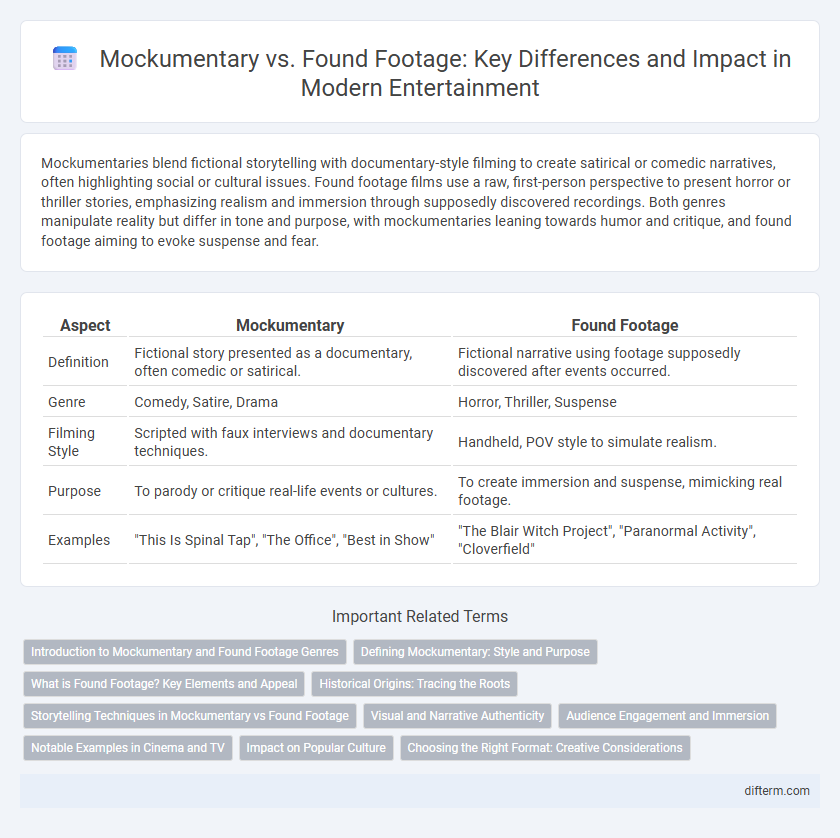Mockumentaries blend fictional storytelling with documentary-style filming to create satirical or comedic narratives, often highlighting social or cultural issues. Found footage films use a raw, first-person perspective to present horror or thriller stories, emphasizing realism and immersion through supposedly discovered recordings. Both genres manipulate reality but differ in tone and purpose, with mockumentaries leaning towards humor and critique, and found footage aiming to evoke suspense and fear.
Table of Comparison
| Aspect | Mockumentary | Found Footage |
|---|---|---|
| Definition | Fictional story presented as a documentary, often comedic or satirical. | Fictional narrative using footage supposedly discovered after events occurred. |
| Genre | Comedy, Satire, Drama | Horror, Thriller, Suspense |
| Filming Style | Scripted with faux interviews and documentary techniques. | Handheld, POV style to simulate realism. |
| Purpose | To parody or critique real-life events or cultures. | To create immersion and suspense, mimicking real footage. |
| Examples | "This Is Spinal Tap", "The Office", "Best in Show" | "The Blair Witch Project", "Paranormal Activity", "Cloverfield" |
Introduction to Mockumentary and Found Footage Genres
Mockumentary and found footage are distinctive subgenres within entertainment that blur the lines between fiction and reality through unique storytelling techniques. Mockumentaries utilize satirical or comedic elements by presenting fictional events in a documentary style, exemplified by films like "This Is Spinal Tap" and "The Office." Found footage relies on raw, unedited-looking recordings to create immersive horror or thriller experiences, with notable examples including "The Blair Witch Project" and "Paranormal Activity.
Defining Mockumentary: Style and Purpose
Mockumentary is a satirical film or television genre that mimics the style and conventions of documentary filmmaking to humorously critique real-life events or societal norms. Its style often includes improvised dialogue, deadpan delivery, and exaggerated characters to create a parody that blurs the line between fiction and reality. The primary purpose of a mockumentary is to entertain while provoking thought by presenting fictional stories with the appearance of factual authenticity.
What is Found Footage? Key Elements and Appeal
Found footage is a filmmaking style that presents fictional events through raw, unedited video footage, often from a first-person perspective, creating a sense of realism and immediacy. Key elements include handheld camera work, diegetic sound, naturalistic performances, and the use of diegetic devices like video cameras or smartphones to justify the presence of the footage. The appeal lies in its immersive storytelling, evoking authenticity and heightened suspense by blurring the line between fiction and reality.
Historical Origins: Tracing the Roots
Mockumentaries originated from early 20th-century satire, with filmmakers like Orson Welles and Peter Watkins pioneering the fusion of fiction and documentary style to critique social issues. Found footage traces its roots to guerilla filmmaking and early horror shorts, such as "Cannibal Holocaust" (1980), leveraging raw, unpolished imagery to enhance realism and immerse audiences in the narrative. Both genres revolutionized cinematic storytelling by breaking traditional narrative structures and engaging viewers through perceived authenticity.
Storytelling Techniques in Mockumentary vs Found Footage
Mockumentaries use scripted dialogue and staged scenarios to parody real-life events, employing satire and irony for comedic or critical effect. Found footage relies on handheld camera work and improvisation, creating a sense of immediacy and realism by presenting the story as raw, discovered recordings. Both techniques immerse audiences differently--mockumentaries blend fiction with documentary style to challenge perceptions, while found footage heightens suspense through a first-person perspective.
Visual and Narrative Authenticity
Mockumentaries employ scripted scenarios and professional actors to simulate real-life events, enhancing narrative authenticity through satire and irony while using polished cinematography. Found footage relies on raw, unpolished visuals captured from the perspective of characters, creating visual authenticity by mimicking amateur recording styles that immerse viewers in a seemingly real experience. This contrast in visual and narrative techniques defines the distinct approaches of mockumentaries and found footage within the entertainment genre.
Audience Engagement and Immersion
Mockumentaries engage audiences through satirical storytelling and humor, blending fictional events with documentary-style presentation to create a sense of authenticity and irony. Found footage captivates viewers by presenting raw, unedited material that mimics real-life discoveries, heightening immersion through shaky camera work and first-person perspectives. Both techniques manipulate narrative realism to deepen audience involvement, but found footage relies more on immediacy and suspense, while mockumentaries emphasize critical reflection and comedic engagement.
Notable Examples in Cinema and TV
Mockumentaries like "This Is Spinal Tap" and TV's "The Office" use scripted satire to mimic documentary style, blending humor with fictional narratives. Found footage films such as "The Blair Witch Project" and "Paranormal Activity" leverage raw, handheld camera work to create a sense of realism and immediacy in horror storytelling. Both genres challenge traditional filmmaking by blurring the lines between reality and fiction, captivating audiences through their distinct approaches to narrative immersion.
Impact on Popular Culture
Mockumentaries, with iconic examples like "This Is Spinal Tap," have influenced popular culture by blending satire and realism, shaping comedic genres and inspiring social commentary through parody. Found footage films such as "The Blair Witch Project" revolutionized horror by creating immersive, suspenseful experiences that popularized DIY aesthetics and viral marketing strategies. Both formats challenged conventional storytelling, leaving lasting effects on audience engagement and genre innovation.
Choosing the Right Format: Creative Considerations
Choosing between mockumentary and found footage formats hinges on the desired narrative style and audience engagement; mockumentaries offer scripted satire with character-driven humor, while found footage delivers raw, immersive realism through purportedly "discovered" recordings. Creative considerations include the tone--mockumentaries excel in parody and social commentary, whereas found footage thrives in suspense and horror genres by leveraging authenticity and immediacy. Budget constraints and production requirements also influence the decision, as found footage often requires minimal sets and practical effects, contrasting with the potentially higher scripting and acting demands of mockumentaries.
Mockumentary vs Found footage Infographic

 difterm.com
difterm.com